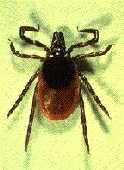
WEDNESDAY, Aug. 3 (HealthDay News) — First they spread Lyme disease, and then babesiosis. Now, deer ticks carrying a newly identified bacterium are infecting residents of the midwestern United States with a disease called ehrlichiosis, and experts say it will likely appear in other areas of the country.
The still unnamed bacterium, which causes fever, body aches and fatigue, has been identified in 25 people in Minnesota and Wisconsin, but has probably infected many more, researchers said in a new study.
“So far we have tested thousands of patients from around the United States, and we have only found it in the blood of patients from Wisconsin and Minnesota,” said lead researcher Dr. Bobbi Pritt, director of the Clinical Parasitology and Virology Laboratories at the Mayo Clinic in Rochester, Minn.
“We have also found it in ticks. Specifically, in the ticks called Ixodes scapularis, also known as the deer tick,” she said. “That’s the same little tick that transmits a number of really serious diseases — Lyme disease, anaplasmosis and babesiosis,” she added.
“Ehrlichiosis is an emerging disease. Its range is expanding throughout the United States,” she said. The bacterium, first identified in 2009, was initially confined to a small area in Minnesota, but now is seen throughout the state and in Wisconsin, Pritt explained.
Lyme disease, once confined to Connecticut, is now a problem throughout the country, Pritt noted.
Ehrlichiosis kills white blood cells, causing a feverish illness. Severe cases can involve the lungs, kidneys and brain, and require hospitalization, but rarely result in death, the researchers said in their report, published Aug. 4 in the New England Journal of Medicine.
In the study, Pritt’s team describes four cases of ehrlichiosis. All four patients recovered after treatment with the antibiotic doxycycline, which is also used to treat Lyme disease. The most severe case of ehrlichiosis occurred in a patient who had had a double lung transplant and needed to be hospitalized for a short time.
Those most at risk for serious cases of ehrlichiosis have compromised or suppressed immune systems, Pritt said.
The best way to prevent ehrlichiosis and other tick-borne illnesses is to protect yourself from deer-tick bites, which are most likely to occur in wooded or grassy areas. “Use caution when going outside, use insect repellent and wear long pants, long sleeves, and check yourself for ticks,” Pritt said. “Also, try to stay out of long grasses and shrubs.”
Doctors might not know to check for ehrlichiosis, Pritt added. The U.S. Centers for Disease Control and Prevention has developed a specific antibody test for the new bacterium, but until it is widely available the study authors suggested doctors use a molecular blood test that detects Ehrlichia DNA in patients who show symptoms.
Genetically, the bacterium is similar to another bacterium — E. muris — that infects small rodents and deer in Eastern Europe, but rarely humans. It has not been reported in North America, Pritt noted.
Infectious disease expert Dr. Marc Siegel, an associate professor of medicine at New York University in New York City, said the report “is testament to the fact that we have more and more ticks, more and more tick-borne illnesses.”
This is also a reminder to doctors that ticks spread diseases other than Lyme, Siegel said.
“So long as there are a growing number of ticks, new bacteria are likely to emerge,” Siegel added. “Moreover, these diseases are likely to spread around the country.”
More information
For more information on tick-borne diseases, visit the U.S. Centers for Disease Control and Prevention.

